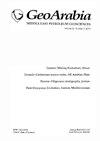沙特阿拉伯反射地震数据成像的五个埋藏的火山口结构
引用次数: 11
摘要
在沙特阿拉伯的油气勘探中获得的反射地震数据揭示了5个直径在5公里到34公里之间的埋藏陨石坑结构。这些构造现今很少或没有地表表现,其年代从奥陶纪到新生代不等。Saqqar构造(29°35′n, 38°42″E)直径34公里,形成于泥盆纪的塑料中。构造被部分侵蚀,上白垩统和古近系地层不整合覆盖,厚度达400 m。Jalamid构造(31°27′n, 39°35″E)在下奥陶统水平直径为19 km,被中奥陶统沉积物填充,目前深度为4,500 m。Banat Baqar构造(29°07′n, 37°36″E)在中奥陶统水平直径为12 km,被上奥陶统沉积物充填,深度为2000 m。Hamidan构造(20°36'N, 54°44″E)在古近纪水平上直径为16 km,被一层薄薄的近代沉积物覆盖。Zaynan构造(20°23′n, 50°08″E)直径5 km,影响深度3800 m的三叠系沉积物,被侏罗系地层充填。除了反射地震成像之外,在这些构造内部或附近还可以获得大量的重力和磁数据以及钻探井。这里讨论了包括撞击坑在内的各种模型。一个结构(Saqqar)已经产生了可能具有冲击变质特征的石英颗粒,这取决于未来的工作,可能支持陨石撞击坑的解释。本文章由计算机程序翻译,如有差异,请以英文原文为准。
Five buried crater structures imaged on reflection seismic data in Saudi Arabia
Reflection seismic data acquired for hydrocarbon exploration in Saudi Arabia have revealed five buried crater structures ranging in diameter from 5 km to 34 km. These structures have little or no present-day surface expression and span a range of ages from Ordovician to Cenozoic. The Saqqar structure (29°35′N, 38°42″E) is 34 km in diameter and is formed in Devonian siliciclastics. The structure is partially eroded and is unconformably overlain by Upper Cretaceous and Paleogene strata up to 400 m thick. The Jalamid structure (31°27′N, 39°35″E) is 19 km in diameter at Lower Ordovician level and is infilled by Middle Ordovician sediments, at a present-day depth of 4,500 m. The Banat Baqar structure (29°07′N, 37°36″E) is 12 km in diameter at Middle Ordovician level and infilled by Upper Ordovician sediments, at a depth of 2,000 m. The Hamidan structure (20°36′N, 54°44″E) is 16 km in diameter at Paleogene level and is overlain by a thin veneer of Recent sediment. The Zaynan structure (20°23′N, 50°08″E) is 5 km in diameter and affects Triassic sediments at depth of 3,800 m, and is infilled by Jurassic strata. In addition to reflection seismic imaging, various amounts of gravity and magnetic data and drilled wells are available in or near these structures. Various models including impact cratering are discussed here for each structure. One structure (Saqqar) has yielded quartz grains with possible shock metamorphic features that, contingent on future work, may support a meteorite impact crater interpretation.
求助全文
通过发布文献求助,成功后即可免费获取论文全文。
去求助
来源期刊

Geoarabia
地学-地球科学综合
自引率
0.00%
发文量
0
审稿时长
>12 weeks
期刊介绍:
Cessation. Published from 1996 to 2015, GeoArabia, The Journal of the Middle Eastern Geosciences was a quarterly journal covering the petroleum geosciences in the Middle East. The journal covers subjects such as: - sedimentology - tectonics - geophysics - petroleum reservoir characterization
 求助内容:
求助内容: 应助结果提醒方式:
应助结果提醒方式:


